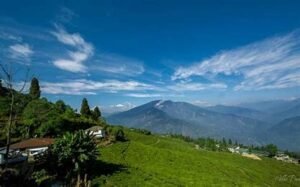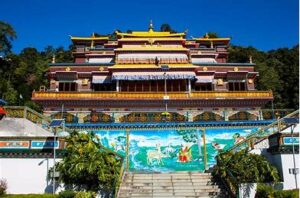Introduction
The Nongkrem Dance Festival is a beautiful cultural event celebrated by the Khasi tribe in Meghalaya, Northeast India. This annual festival is a way of expressing gratitude to the Almighty for a prosperous harvest and seeking blessings for peace, wealth, and communal harmony. Held mostly in November at Smit, the cultural headquarters of the Khasi Hills, it attracts numerous locals who gather to witness the traditional rituals and dances performed with great devotion. The festival acts as a bridge that connects the present generation with their ancestral past, reaffirming their commitment to preserving their unique cultural identity.
Historical Roots
The Nongkrem Dance Festival holds deep historical significance for the Khasi tribe. It is rooted in ancient rituals passed down through generations, symbolizing continuity and resilience. The festival is said to have evolved from age-old ceremonies performed to honor the divine and seek blessings for the prosperity and welfare of the community. Traditionally, the rituals were associated with the agricultural cycle, particularly the harvest, which was crucial for the survival of the tribe. Over time, the festival has become a vital part of the Khasi tribe’s cultural heritage, preserving their identity amidst changing social and economic landscapes.
Language and Communication
Language plays a fundamental role in the preservation and expression of cultural identity. The Khasi language, which belongs to the Austroasiatic family, is an essential medium of communication during the festival. Khasi songs, chants, and prayers are recited with great reverence throughout the rituals and dance performances. The oral nature of the festival’s transmission emphasizes the significance of storytelling and spoken words, which are integral to the tribe’s cultural memory. Additionally, the use of the Khasi language reinforces cultural pride and strengthens bonds within the community.
Festivals and Celebrations
The Nongkrem Dance Festival is celebrated with elaborate rituals and dances performed over several days. The rituals are led by the Syiem (chief) and his ministers, who conduct sacred rites to appease the ancestors and seek divine blessings for the welfare of the tribe. Men and women, dressed in traditional attire, perform graceful dances accompanied by the rhythmic beat of drums, pipes, and other traditional instruments. The Shad Nongkrem, the dance performed by young women in a circular motion, symbolizes purity, grace, and devotion. Meanwhile, men perform the Shad Mystieh, a warrior-like dance representing strength and valor. These dances are not merely artistic performances but are believed to convey spiritual messages and blessings.
Arts, Crafts, and Music
Artistic expression is a significant aspect of the Nongkrem Dance Festival. Traditional Khasi music, including drum beats, flute melodies, and chants, accompanies the dances, creating an enchanting atmosphere. The music reflects the tribe’s deep connection to nature and their ancestral beliefs. Artisans from the Khasi tribe showcase their craftsmanship through the creation of intricate ornaments, attire, and musical instruments used during the festival. Silver and gold jewelry, particularly worn by women, signifies prosperity and social status. The crafting of these ornaments requires skill and dedication, making them a testament to the tribe’s rich cultural heritage.
Cuisine and Culinary Traditions
Food plays an essential role in the Nongkrem Dance Festival, symbolizing unity and hospitality. Traditional dishes such as Jadoh (rice cooked with meat), Dohneiiong (pork with black sesame seeds), and Putharo (rice cakes) are prepared and shared among the community. The communal feast represents the tribe’s collective gratitude for a successful harvest. Culinary traditions passed down through generations are preserved and celebrated during the festival, contributing to the tribe’s cultural continuity.
Attire and Ornamentation
The traditional attire worn during the festival is vibrant and symbolic, reflecting the tribe’s cultural pride. Women wear the Jainsem, a traditional Khasi dress made of silk with intricate designs, while men wear dhotis and turbans. The attire is complemented by beautiful silver and gold ornaments, such as necklaces, earrings, and bracelets, which represent wealth, prosperity, and social status. The careful preparation and adornment of traditional clothing during the festival highlight the tribe’s dedication to preserving their heritage.
Beliefs and Values
The Nongkrem Dance Festival embodies the core values of the Khasi tribe, including respect for nature, ancestral worship, and communal harmony. The rituals and dances are a way of honoring the spirits and seeking their blessings for peace, prosperity, and good health. The festival also emphasizes the importance of unity within the community, fostering a sense of belonging and collective responsibility.
Customs and Etiquette
Respect and humility are fundamental aspects of the Nongkrem Dance Festival. The tribe’s customs dictate that visitors and participants should observe the rituals with reverence and avoid disrupting the ceremonies. Traditional etiquette emphasizes maintaining harmony and showing respect toward the cultural practices of the community. The strict adherence to customs during the festival reflects the tribe’s commitment to preserving their traditions.
Architecture and Symbols
Traditional Khasi architecture is often showcased during the festival, with houses built from natural materials such as wood, bamboo, and thatch. These structures symbolize the tribe’s connection to nature and their sustainable way of life. Symbols of prosperity, such as agricultural tools, livestock, and natural elements, are incorporated into the rituals, representing the tribe’s dependence on nature for sustenance and survival.
Oral Traditions and Storytelling
The Khasi tribe has a rich oral tradition that is prominently displayed during the Nongkrem Dance Festival. Elders share stories of their ancestors, the origin of the festival, and the significance of the rituals. These stories, passed down through generations, serve as a means of preserving cultural knowledge and educating the younger generation about their heritage.
Interactions with Nature
Nature plays a central role in the Nongkrem Dance Festival. Rituals are performed to thank the divine for the harvest and to ensure the fertility of the land. This deep connection with nature is reflected in the dances, prayers, and offerings made during the festival. The Khasi tribe’s respect for nature is a testament to their sustainable practices and reverence for the environment.
Challenges and Preservation
Like many indigenous cultures, the Khasi tribe faces challenges in preserving its traditions. Modern influences, urbanization, and changing lifestyles threaten the purity of the festival. However, community initiatives and cultural organizations are working to maintain its authenticity and promote awareness of its significance.
Contributions to Society
The festival promotes unity, cultural pride, and social cohesion within the Khasi tribe. It serves as a reminder of their values and their connection to their ancestral heritage. Learning about and respecting such traditions helps keep them alive for future generations. Let’s appreciate and support the cultural heritage of the Khasi tribe by promoting awareness and understanding.




